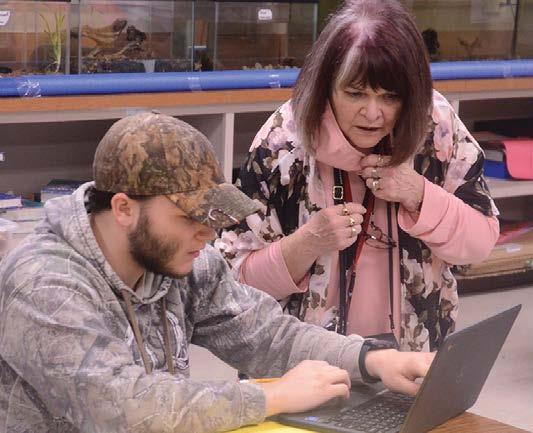
6 minute read
Entegrity
from March 2022
by ASBA
KIRBY SUPERINTENDENT PIKE PALMER, elementary principal Dolores Cowart, and high school principal Jason Burns talked to numerous administrators as Kirby considered making the switch. Cowart and Burns say they now have qualified teachers from other districts contacting them asking when jobs might be available. Burns said morale among students has improved. Four days is less daunting than five. Not only did Friday classes go away, but so did “hump day.”
far away, already had numerous fourday districts. Palmer brought the idea to the school board. Administrators contacted four-day districts in Oklahoma and Missouri. Kirby High School Principal Jason Burns said nobody had any complaints.
“Everybody had their different positives, but when I’d say, ‘What’s one negative you can think of?’ they would say, ‘Nothing,’” he said. “The only thing that anybody ever said was at first it was childcare. But every one of them told me that there would be people in the community upset about it or whatever when you’re talking about it, but they said once you start, you won’t hear anything else about it.”
Patrons were presented pros and cons at a couple of community meetings. Roughly 90% were in favor. In March 2019, the school board voted 7-0 to implement the plan.
The district at the time was struggling with enrollment. After being hired in
Continued on next page
Cedar Ridge Schools & Midland School District Solar Array feat. New Grounds Crew: Dorper Sheep
REDUCE

THEN PRODUCE
Let the experts at Entegrity show you how to first REDUCE your energy use and then PRODUCE clean renewable energy.
2016, Palmer appeared before the State Board of Education his first three years because the district had less than 350 students. At one point, the district was at 330.
That’s not a problem anymore. The summer after the district publicized it was making the change, its fall enrollment jumped from 350 to 390, and now it’s hovering around 400. The district has been losing fewer students while gaining students from elsewhere. Palmer said the four-day week isn’t the only reason for the gains, but it’s definitely had an effect.
Meanwhile, the district has kept its current teachers while attracting new ones. Palmer said the district’s salaries are similar to nearby ones, but only Kirby has been able to offer a three-day weekend. Burns said he has a file with 30 inquiries, about 20 of them teachers. When he first arrived, his first two hires weren’t certified, but they were the only ones who applied for the jobs.
Palmer said his teachers would “have a riot” if the district tried to return to a five-day school week. Educators told Report Card they like the new schedule. Kay Kinard, a third grade math and science teacher and Kirby graduate who taught 10 years at another school, had worried she would not be able to fit five days into four. Instead, she likes the longer class periods, which she said let her slow down and teach the standards until students understand them. She said she and her students have become more efficient and work until it’s time to go to the next class. High school math teacher Laura Mack is devoting more class time to homework assignments, allowing her to help them understand the work.
“I feel like they are learning as much if not a little bit more just because I have an additional time with them every day,” she said.
The change has given staff and students a day to do personal things that previously had to be crammed into the five-day week, like medical appointments. Kinard said her own child was getting tubes in his ears that upcoming Friday, which meant she didn’t have to take off work. She said she can come to the school and plan on Fridays, which previously would have been done on Saturdays or Sundays. Dyslexia therapist Shelly Greene cleans her house on Fridays now so she can have Saturdays for other activities. Quin Johnson, a biology and environmental science teacher, said students are talking up the four-day week to their friends from other districts.
Arkansas was the last state west of the Mississippi River where schools began adopting the four-day week, said Dr. Jon Turner, an associate professor at the Missouri State University Department of Counseling, Leadership and Special Education. The schedule is common in some states with large rural districts and those in the Mountain West. The majority of Colorado schools are on a four-day week, and it’s been available there for many decades. It’s also common in neighboring Oklahoma and Missouri. In contrast, it’s somewhat rare east of the Mississippi River.
Of the 518 public non-charter schools in Missouri, 119 are on the four-day week. It’s been available there for 11 years and became popular when a financial downturn reduced state funding to schools. In that 11 years, 120 districts have tried the idea, and only one has gone back. The growth is driven by small, rural school districts who were losing teachers to larger districts in cities that could offer more money. The largest district with a four-day week, Warren County Schools, a St. Louis suburb, has 3,800 students.
Turner said districts made the move thinking they would attract new graduates to teaching but have found they are attracting experienced teachers. It hasn’t made a difference in student growth because Missouri doesn’t have school choice.
Nationwide, studies have shown that moving to a four-day week does not have a significant effect on academic performance, Turner said. When a district maintains the same number of hours, there is no definitive evidence that it decreases performance. In Oregon, many districts lost 40-60 hours of instructional time when they switched, which could affect scores. Research out of Colorado seems to show a temporary bump in English and math scores, but that could be because those schools were doubling the amount of professional development and collaboration time among teachers. One superintendent in Missouri said state testing takes longer because students have been told that if test scores fall, the district will return to a five-day week, so they take it more seriously. Teachers are more focused, too.
Kirby teachers and administrators cannot say definitively how the change has affected students’ academic performance. Scores have come up, fallen down, and stayed about the same. The disruptions and lack of testing caused by COVID have made it even harder to gauge the transition’s impact.
But high school principal Jason Burns said the students’ demeanor seems better in the hallway. On Monday mornings, the end of the school week does not seem so far away.
“You take away Friday, but we also really to me got rid of hump day, too,” he said. “By the time you get home Tuesday, you’re halfway done.”
Burns said the new schedule also helps his students have time for their jobs – some of which contribute to paying their families’ bills.











